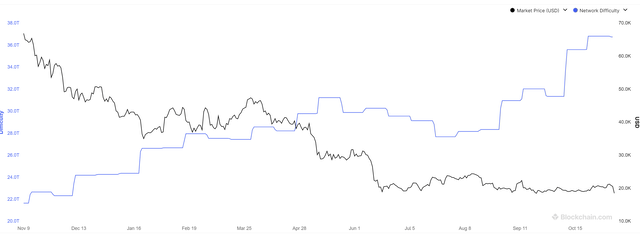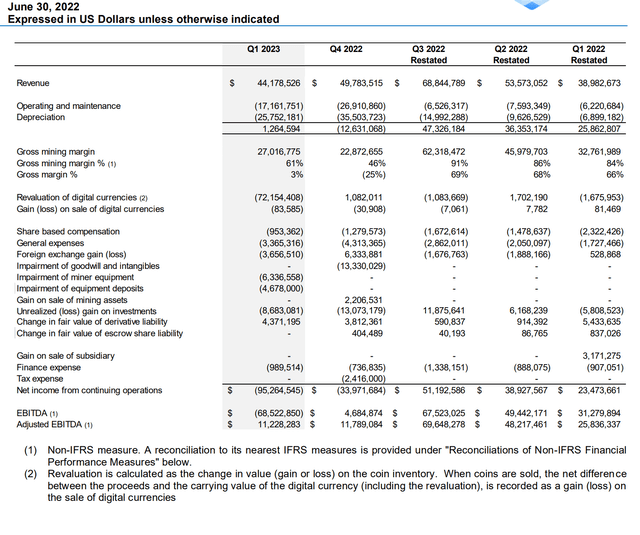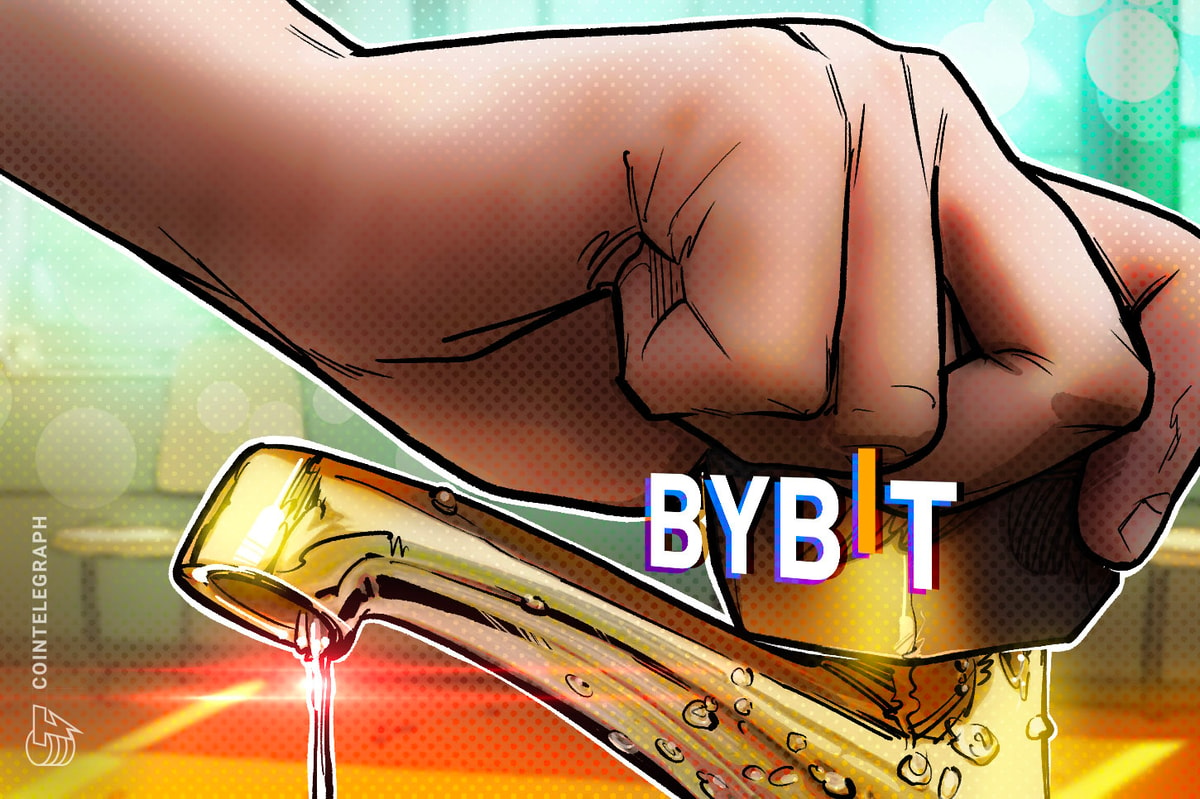
luza studios
A few months ago, I wrote a cautious article on HIVE Blockchain Technologies Ltd. (NASDAQ:HIVE), highlighting some red flags in the company’s Q4/2022 earnings report. In particular, I was worried that HIVE’s Ethereum (ETH-USD) mining equipment may become obsolete with a pending transition to a “Proof-of-Stake” (“POS”) system. I was also worried about HIVE’s mining margins, as HIVE had been mining at negative gross margins in Q4/2022. Since my article, HIVE has declined over 30%.
After reviewing the latest figures from HIVE’s monthly production reports and cryptocurrency prices, I continue to recommend investors stay away. At current crypto prices, HIVE appears to be mining at negative gross mining margins, i.e. not even covering the cost of electricity. The loss of Ethereum mining has dealt a heavy blow to HIVE’s operations. Combined with increased Bitcoin (BTC-USD) mining difficulty, HIVE’s monthly production of BTC has declined 40% from August to October despite adding 7% in ASICs.
Ethereum Merged And Its Impact On HIVE
When I wrote my initial article, there was still quite a bit of doubt about the pending Ethereum conversion to POS. In fact, HIVE itself had been downplaying the timeline and impact, with the company making fun of the long delayed transition in their Q3/F22 presentation (Figure 1).

Figure 1 – HIVE downplayed Ethereum merge (HIVE Q3/F22 Presentation)
Unfortunately for HIVE and other Ethereum miners that derived revenues from Proof-of-Work on the Ethereum network, the Ethereum network successfully merged to a POS system on September 15, 2022. The merge made Ethereum mining equipment obsolete, with many GPUs now selling below MSRP and list prices.
As a reminder, HIVE had 6.49 Terahash of Ethereum mining capacity at the end of August, which produced 3,010 ETH (equivalent to 228.4 BTC, according to HIVE). HIVE also mined 290.4 BTC in August, using their dedicated ASIC miners, so in total, the company produced 518.8 BTC equivalent.
In response to the Ethereum Merge, HIVE commented that the company would be pivoting its business to focus on Bitcoin, including the digital treasury assets (i.e. it would no longer HODL ETH). Since the merge, HIVE revenues from GPU mining were dramatically reduced, from ~7 BTC/d to 1.6 BTC/d, as the GPUs were converted to mine alt-coins.
In September, the transition month, HIVE mined 268.9 BTC from ASIC mining, 1,394 ETH (equiv. to 111.6 BTC), and 15.8 BTC from GPU mining of alt-coins for a total of 396.3 BTC.
In October, the 1st month of BTC only mining, HIVE mined 262 BTC from ASIC mining and 45 BTC from GPU mining for a total of 307 BTC.
So as a result of the Ethereum merge, HIVE’s BTC equivalent mining production declined by over 40%, from 519 BTC in August to 307 BTC in October.
Bitcoin Difficulty Continue To Climb; HIVE Running On A Treadmill
Further compounding HIVE’s Ethereum problem was the fact that the difficulty to mine Bitcoin continued to climb, recently pushing new all-time highs despite the fall in Bitcoin prices (Figure 2).

Figure 2 – Bitcoin difficulty vs. price (blockchain.com)
So even as HIVE continued to add ASIC mining rigs, with its ASIC hashrate increasing 7% from 2.23 Exahash in August to 2.38 Exahash in October, the number of BTC it mined from ASIC mining actually declined 10% from 290 BTC in August to 262 in October.
What Is HIVE’s Margin Now?
Revisiting my concern on HIVE’s margin profile, admittedly, I was too bearish in my prior article when I pointed out HIVE was mining at negative gross margin in Q4/F22, as a number of one-off expenses had inflated operating and maintenance expenses. In the first quarter results reported in August, Gross Mining Margin expanded QoQ to 61%, as operating and maintenance costs normalized somewhat to $17.2 million. However, I was directionally correct, as HIVE’s Gross Margin, which included depreciation of mining equipment, was only 3% in Q1/F23 (Figure 3).

Figure 3 – HIVE operating summary (HIVE Q1/F23 MD&A)
Are Gross Mining Margins Now Zero?
Looking forward, we are at an interesting juncture. On November 9th, Bitcoin crashed to ~$17,000 as one of the seemingly ‘untouchables’ of the industry, FTX, was forced to seek a bailout from its main rival, Binance.
What is interesting is that, if we assume HIVE’s Q1/F23’s operating and maintenance costs are the norm, that works out to a daily mining cost of ~$190k ($17.2 million over 91 days). From the October production update, we also know that:
As of November 2, HIVE is producing an average of over 9.5 Bitcoin per day from ASIC and GPU production, comprised of over 8 Bitcoin per day from our ASIC fleet and over 1 Bitcoin per day from our GPU fleet.
Even if we are generous and assume HIVE produces 10 BTC per day, at current bitcoin prices, HIVE is only generating $170,000 / day (10 BTC times $17,000 / BTC) in revenues.
Therefore, it is very possible that HIVE is currently mining at a negative gross mining margin. This would mean mining revenues cannot even cover the electricity costs.
Risks To Bearish View
Obviously, the biggest risk to my bearish view is going to be cryptocurrency prices. In August, following my last article, HIVE briefly topped $7/share as risk assets had a summertime rally. However, I think over the long run, HIVE cannot escape from the reality that at current crypto prices, its mining gear may be basically burning energy and money as it mines at negative gross mining margins.
Summary
In summary, I continue to be wary of HIVE. At current crypto prices, HIVE appears to be mining at negative gross mining margins. The loss of Ethereum mining has dealt a heavy blow to HIVE’s operations. Combined with increased BTC difficulty, HIVE’s monthly production of BTC has declined 40% from August to October despite adding 7% in ASICs.
Read More: news.google.com








 Bitcoin
Bitcoin  Ethereum
Ethereum  Tether
Tether  XRP
XRP  Solana
Solana  USDC
USDC  Dogecoin
Dogecoin  Cardano
Cardano  TRON
TRON  Lido Staked Ether
Lido Staked Ether  Wrapped Bitcoin
Wrapped Bitcoin  Toncoin
Toncoin  Chainlink
Chainlink  LEO Token
LEO Token  Stellar
Stellar  Wrapped stETH
Wrapped stETH  USDS
USDS  Avalanche
Avalanche  Sui
Sui  Shiba Inu
Shiba Inu  Hedera
Hedera  Litecoin
Litecoin  Polkadot
Polkadot  MANTRA
MANTRA  Bitcoin Cash
Bitcoin Cash  Bitget Token
Bitget Token  WETH
WETH  Ethena USDe
Ethena USDe  Binance Bridged USDT (BNB Smart Chain)
Binance Bridged USDT (BNB Smart Chain)  Pi Network
Pi Network  Hyperliquid
Hyperliquid  Wrapped eETH
Wrapped eETH  WhiteBIT Coin
WhiteBIT Coin  Monero
Monero  Uniswap
Uniswap  Dai
Dai  Aptos
Aptos  Pepe
Pepe  NEAR Protocol
NEAR Protocol  sUSDS
sUSDS  Cronos
Cronos  OKB
OKB  Coinbase Wrapped BTC
Coinbase Wrapped BTC  Gate
Gate  Tokenize Xchange
Tokenize Xchange  Mantle
Mantle  Ondo
Ondo  Internet Computer
Internet Computer